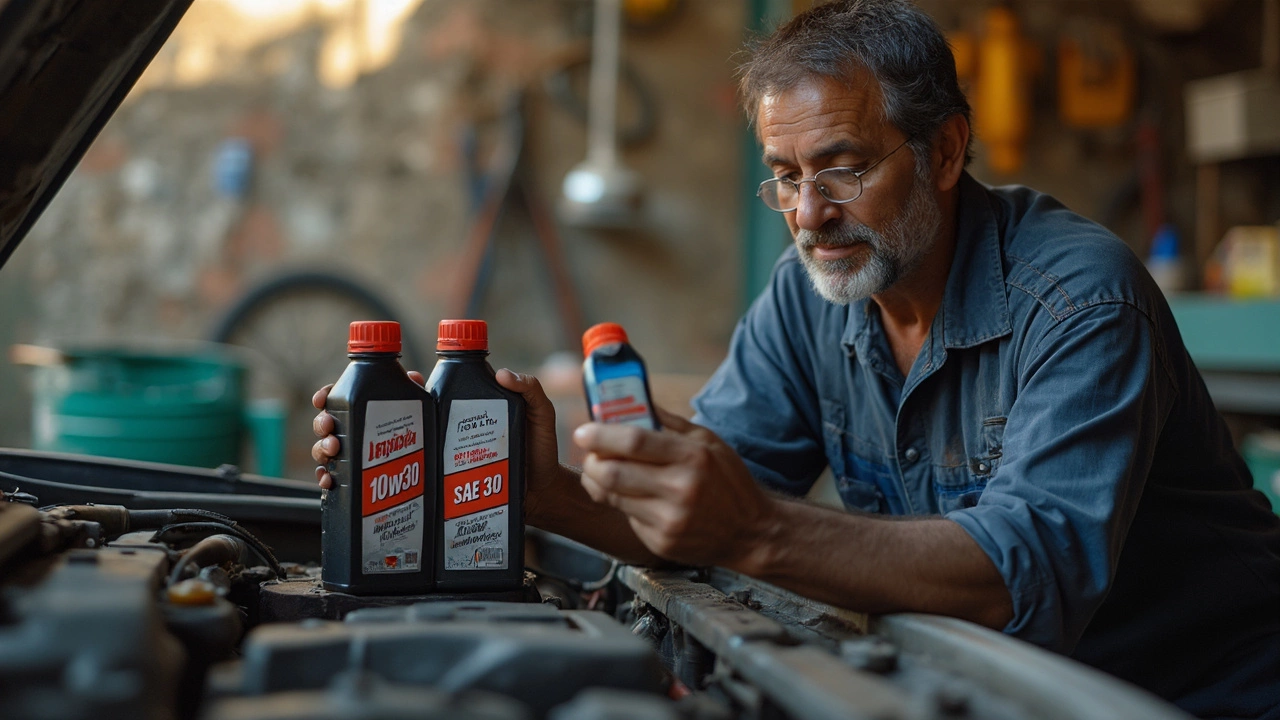Anyone who’s peered at the shelves in the oil aisle has seen bottles labeled 'SAE 30' and '10w30.' They look similar, but there’s a world of difference under the cap. Messing around with the wrong oil isn’t just a harmless mix-up—it can wreck your engine if you’re not careful. Changing these oils isn’t the same thing as just swapping between different brands of laundry detergent. Your engine actually relies on some basic science to keep running smoothly.
If you’re thinking of reaching for SAE 30 instead of 10w30 because it’s cheaper or already sitting in your garage, it’s smart to hit pause. These oils have different jobs, and using the wrong one could mean engine noises, poor starting in winter, or worse—serious damage that kills an afternoon and hurts your wallet. Even people who love tinkering in the garage sometimes make the wrong call, just because oil labels look confusing. Let’s clear up what these oils actually do and what you’ll run into if you use one instead of the other.
- SAE 30 vs 10w30: What Do These Numbers Mean?
- How Viscosity Impacts Engine Performance
- Cold vs Hot Weather: Does the Oil Matter?
- Which Engines Can (and Can’t) Handle SAE 30?
- Real-Life Risks and Problems You Might Face
- Tips for Picking the Right Engine Oil
SAE 30 vs 10w30: What Do These Numbers Mean?
If you’ve ever scratched your head looking at a bottle of SAE 30 or 10w30 engine oil, you’re not alone. These codes aren’t random—they really matter. The "SAE" stands for the Society of Automotive Engineers, the folks who created the scale for measuring oil thickness, or viscosity.
Here’s the breakdown. SAE 30 is what’s called a "single-grade" oil. It means that it keeps about the same thickness when it’s hot. This oil doesn’t flow well in cold weather, and it’s mainly made for older motors, lawn mowers, simple tractors, or small engines that stay above freezing temperatures.
On the other hand, 10w30 oil is “multi-grade.” That’s where the "10w" and "30" come in. The "10w" shows how the oil behaves in winter (that’s what the "w" stands for), and the "30" is its thickness at high engine temps. So 10w30 flows better when it’s cold but still protects your engine when it’s hot. Most modern cars and trucks use multi-grade oil because it’s just more flexible year-round.
“Engine oil viscosity affects everything from cold starts to engine wear. Using the right grade is one of the simplest ways to extend engine life.” — Edmunds, automotive resource
Here’s a quick look at how these two stack up:
| Type | Viscosity (Cold) | Viscosity (Hot) | Best Use |
|---|---|---|---|
| SAE 30 | Thick (slow flow) | Thick | Summer, small engines |
| 10w30 | Thinner (flows easier) | Thick | Most cars, changing temperatures |
The real difference? 10w30 is basically an oil that adapts—stays runny in winter so your car starts, and still protects when things get hot. SAE 30 is more old-school, sticking to one job in stable, warmer conditions.
How Viscosity Impacts Engine Performance
Viscosity is just a fancy word for how thick or runny your engine oil is. This matters more than most folks realize. If you pour maple syrup into your car instead of 10w30, it won’t flow fast enough. Too thin, and it can’t protect engine parts. Too thick, and it drags the whole system down, making your engine work harder than it should.
SAE 30 is a straight-weight oil—it has one thickness, no matter the temperature. 10w30 is different. The “10w” tells you how well it flows in cold weather (the ‘w’ stands for 'winter'). The “30” part tells you how it behaves when the engine is hot. So 10w30 stays thin enough to move at startup, and thick enough to protect your engine as it heats up. That’s a big deal, especially if you drive where the weather actually changes.
Everything inside your engine—from tiny bearings to larger gears—depends on oil making it everywhere quickly. The right oil viscosity lets lubrication reach all moving parts fast during startup, reducing wear before things heat up and oil thins out. Get it wrong, and that grinding noise you hear is metal rubbing with not enough protection. That’s not good.
- Thinner oil (lower viscosity) flows easier—great for cold starts.
- Thicker oil (higher viscosity) stands up better to high temperatures—good for older engines or hot climates.
- 10w30 gives you both: solid cold-start flow and good heat protection.
- SAE 30 only protects well at moderate to hot temps but can struggle to lubricate on chilly mornings.
Back in 2021, a test run by the American Petroleum Institute showed that using oil with the right viscosity improved engine efficiency by up to 3%. Even a small gain like that adds up over years of driving—less fuel burned, fewer repairs, less hassle overall.
Pick your oil based on how and where you really drive. If you regularly start up the car on frosty mornings, don’t skimp—reach for something like 10w30 instead of SAE 30. Your engine and your future self will thank you.
Cold vs Hot Weather: Does the Oil Matter?
The outside temperature actually has a big effect on how engine oil like SAE 30 and 10w30 behaves inside your engine. Here’s the deal: oil doesn’t just sit there, it moves through tiny spaces in your engine, and its thickness (or viscosity) changes depending on how hot or cold it gets.
With 10w30, the “10w” part means it stays thinner in cold weather. That’s good because thin oil flows fast and protects your engine during those first seconds after you turn the key on a frosty morning. If you use SAE 30 in winter, you’re in trouble. This oil gets thick when cold—think honey in the fridge—so it moves slowly and takes longer to coat all the parts. That delay can cause metal-on-metal contact, which eats away at your engine’s guts.
- 10w30 is designed for year-round use and is multi-grade—it adapts to high and low temps.
- SAE 30 is mono-grade and best suited to warm weather or summer use only.
- If you run SAE 30 during winter, your oil pump might struggle, and you might even have trouble starting your car.
Now, flip the situation. In hot weather, both SAE 30 and 10w30 act similar because the “30” means they have the same thickness at operating temp. So, if you live where winters are mild or you’re using a lawnmower (not a car), SAE 30 isn’t going to mess up your machine. But in most climates, engines face temperature swings throughout the year, and 10w30 is made to handle those changes.
| Engine Oil | Cold Start Performance | Best Season |
|---|---|---|
| 10w30 | Flows easily, protects on startup | All year (especially cold weather) |
| SAE 30 | Thick, slow flow, poor cold protection | Warm months only |
If you’ve ever tried starting your car on a freezing morning with the wrong oil, you know how rough it sounds. That’s your engine begging for the right kind of lubricant. Using the correct engine oil for your weather isn’t just a good idea—it’s what keeps everything running longer, smoother, and with less drama.

Which Engines Can (and Can’t) Handle SAE 30?
SAE 30 oil isn’t a 'one-size-fits-all' deal. This stuff is classified as a single-grade oil, which means it keeps the same thickness as long as your engine is hot. That’s a win for certain engines, but not all. Let’s break down where SAE 30 works—and where it really doesn’t.
SAE 30 is most often used in small, air-cooled engines. Think lawn mowers, pressure washers, generators, older garden tractors, and some motorcycles made before the year 2000. These engines usually run at steady temperatures, so they don’t mind oil that stays just one viscosity once warmed up. For these types of engines and tasks, SAE 30 is kind of the gold standard, especially during the warmer months.
But here’s where you get into trouble: Modern car engines. Today’s engines expect multi-grade oil—like 10w30—because your car needs protection during cold starts and hot highway runs. 10w30 is designed to stay thin enough for cold cranking, but thick enough at normal operating temps. SAE 30, on the other hand, thickens up too much in cold weather and just doesn’t flow well when you first turn the key on a frosty morning. That means engine wear, hard starts, and possible damage. Plus, many modern cars and trucks have tighter engine tolerances and fancier tech (like variable valve timing) that demand the extra ‘smarts’ of multi-grade oil.
Here’s a quick table to spot which engines can (and can’t) handle SAE 30:
| Engine Type | OK with SAE 30? | Notes |
|---|---|---|
| Lawn mower or garden tractor | Yes | Perfect in warm weather |
| Portable generator | Yes | As long as temps stay above freezing |
| Older motorcycles (pre-2000) | Yes | Check manual for specifics |
| Modern car or truck | No | Use 10w30 or manufacturer-spec oil |
| Snowblower | No | Needs multi-grade oil for cold starts |
If you ever wonder what oil to use, check your owner’s manual, especially for anything with a complicated engine. Manufacturers are picky about oil because they know what keeps things running. Mess up this choice and you’re basically gambling with engine life—for no reason.
Real-Life Risks and Problems You Might Face
Swapping out SAE 30 for 10w30 (or the other way around) might seem harmless, but engines notice the difference right away. Here’s what actually happens if you cut corners with engine oil.
The first thing most people spot: rough starts in the cold. SAE 30 is a single-grade oil, so it’s pretty thick when temperatures drop. If you dump it in your car in winter, you'll probably hear grinding, sluggish cranking, or just get no start at all. The oil turns into goo when it’s cold outside—it won’t get where it needs to go fast enough. In contrast, 10w30 stays thinner in the cold so your engine cranks up quicker and the oil reaches vital parts fast.
Next up, there’s the risk of poor lubrication. Put simply, thick oil in a modern engine designed for multigrade stuff won’t slip into tiny gaps quickly. You might end up with extra engine wear. No one wants to shell out for a full engine rebuild because the wrong oil was used for one season. Small engines on lawnmowers are often OK with SAE 30, but cars and trucks? Mostly a no-go, especially newer models.
Heat brings a different set of headaches. 10w30 is built to work well in both heat and cold, so it doesn’t thin out too much on hot summer days. SAE 30 keeps its shape in heat, but if your engine revs high (think modern cars), the oil might break down faster. Thinner oil on a blazing day can reduce oil pressure and make your car run noisy—or even trigger warning lights on your dash.
Here's a quick breakdown of the main differences you’ll actually notice in normal driving conditions:
| Issue | SAE 30 | 10w30 |
|---|---|---|
| Cold starts | Poor/Sluggish | Smooth/Quicker |
| Wear protection | Only in warm weather | Year-round |
| Modern engine safety | Not recommended | Recommended |
| Oil leaks/seepage | More likely (if too thick or thin) | Less likely (designed balance) |
Some folks might tell you it’s “just oil,” but a single choice can cause higher oil consumption, hot weather breakdowns, or extra trips for top-ups. One study run by an actual engine lab (check Southwest Research Institute if you want specifics) found wrong oil grades can easily cut engine life by over 15%.
Here’s a helpful checklist before switching oils:
- Only use SAE 30 for small engines unless your car’s manual specifically calls for it.
- For daily drivers, always reach for 10w30 or what the manual says.
- If the engine is hard to start, double-check what oil you used last—wrong grade is a common cause.
- Look for unusual noises, leaks, or increased oil use after an oil change. Those are red flags.
Your engine doesn’t care if you’re trying to save a few bucks—it just needs the right oil. Following label advice isn’t just corporate talk; it's what keeps your engine spinning long after the warranty runs out.
Tips for Picking the Right Engine Oil
Picking the right engine oil can feel like a guessing game, but it doesn’t need to be. Here’s what actually matters when you’re staring at a bunch of bottles in the store or shopping online for SAE 30 and 10w30.
- Always check your owner’s manual first. It spells out which oil to use—sometimes in bold letters. Auto makers know what works best for your specific setup, and ignoring their advice? That’s asking for problems down the road.
- Pay close attention to viscosity numbers. The “10w” in 10w30 means it flows well at cold temperatures (the “w” stands for winter), while the “30” shows how it performs when your engine is hot. SAE 30 only gives you the hot weather rating, so it’s not good when it’s cold out.
- Consider your climate. If you live where it gets freezing in the winter, go with a multi-grade oil like 10w30. Single-grade oils like SAE 30 get thick and sluggish in the cold, making it hard for your car to start and for the oil to reach all the moving parts.
- Think about your driving habits. Lots of short trips without letting the engine really warm up? That’s another reason to choose an oil that handles both cold and hot temps, like 10w30.
- Don’t ignore your warranty. Using oil that doesn’t match manufacturer recommendations can sometimes void your warranty, and no one wants an expensive repair bill that’s all on you.
- Look for API certification on the label. The round symbol with “API” tells you the oil meets common industry standards. This matters if you care about long-term engine health.
Here’s a quick snapshot showing what each oil type is usually good for:
| Oil Type | Best Use | Cold Weather? | Common in |
|---|---|---|---|
| SAE 30 | Small engines, older lawn mowers | No | Lawn equipment, classic cars |
| 10w30 | Modern engines, daily drivers | Yes | Cars, light trucks |
One last thing: Don’t get tripped up by marketing or assume the most expensive oil is always better. Stick to what your engine was built for. Your wallet and your car will both thank you in the long run.




